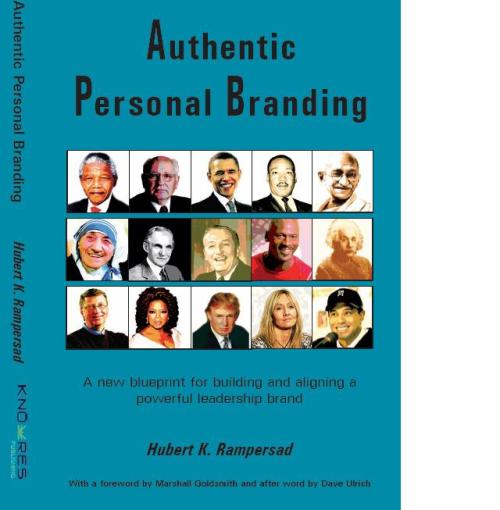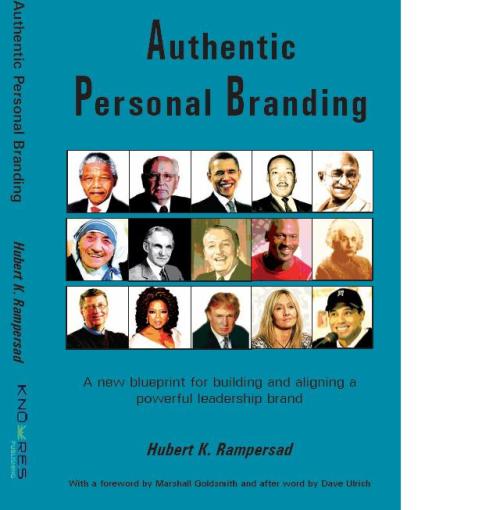
From the after word of Dr. Hubert Rampersad’s new best selling book “Authentic Personal Branding: A new blueprint for building and aligning a powerful leadership brand’ (Information Age Publishing, USA; Pearson Malaysia; Sarabooks, New Delhi; Knowledge Resources, South Africa; Alphina, Vietnam; Olympus Business, Moscow; 2008 ).
—————————————————————–
When you have read Hubert Rampersad’s outstanding book Authentic Personal Branding, you will probably wondering “what does this all mean?” It is nearly impossible to retain all the details of four stages of the authentic personal branding model, you will want to remember some of the messages of this book and how they can be applied to you and your personal and professional life. Of course, you may want to refer back to some of the simple and elegant models for personal and company ambition, objectives, critical success factors, and actions. Hubert has a knack for preparing comprehensive frameworks for analyzing important issues. You may also want to reflect on many of the self and organization diagnostic questions that offer you insight into your brand and your company’s brand. These mental models and their related investigative questions will help you know where you are today so you can get to where you want to be tomorrow.
We tend to like books and ideas that confirm and inform our thinking. Both of these are true for me of this book. With my colleagues Wayne Brockbank, Norm Smallwood, and Jon Younger, we have thought, debated, and written about issues related to firm, leadership, and personal brand.[i] We have tried to understand how to help leaders develop leadership within their companies, how to build talent throughout a company, and how to use HR practices to create and sustain value. Many of the themes in this book confirm our thinking. But, this work also informs our thinking and helps us move forward in what we know and do. While each reader will glean unique insights from this book, let me try to capture some of my key takeaways.
1. Personal brand exists
Whether we like it or not, we all have a personal brand. We have an identity that we are known for by those who know us both best and least. This personal identity sends signals about how we want to be treated and filters how others connect, interact, and deal with us. When our personal brand is implicit and unintentional we may be surprised by how we interact with others. When our personal brand is deliberate and disciplined, we can shape how we are treated. Our lives are much less complicated when we identify and act on our personal brand.
When I was leading a mission for our Church, I supervised over about 500 young men and women who dedicated 18 to 24 months of their lives doing community service. During this time, they lived a very monkish existence, abstaining from the normal social and party norms of their generation. They worked to recognize and teach moral principles and they abstained from things would detract them from their mission. At the end of their service, they returned back into the “real” world where they would be tempted to succumb to more worldly patterns. One young man was very worried since on leaving his mission he would be joining the military. In our final interview, he expressed concern that he would be able to continue to live the values that he had assimilated during his mission. We talked about the 4 3’s. I promised him that if he would live his values without fanfare for 3 hours, 3 days, 3 weeks, and 3 months, that he would not struggle to live his values. He tested my ideas. About 6 months later we saw him and he said that he now found it easy to live his values. After 3 months of doing what he felt was right, he had developed a reputation (or personal brand) that others knew him for. His fellow troops had learned what he values and they saw that he lived those values. They honored his expectations and in fact protected him from strangers who did not know him by saying “don’t invite Cody to this activity, it is not something he would be interested in.”
When we are intentional about our personal brand, others will respect us and help us retain our brand. If we are not clear about our personal brand, and our behaviors vary, others will not know how to treat us and we struggle for consistency in our lives.
2. Personal brand can be created and evolved
When I decided I wanted to be a teacher for a living, I recognized that public speaking was not my predisposition. As a strong introvert, I found it difficult to be in front of groups. Yet, I knew that if I was going to be a good presenter, I needed to replace fears with confidence. I wanted to develop a reputation an engaging and thoughtful teacher. So, I observed some of the best professors in the world at the University of Michigan and elsewhere. I took notes less on what they said and more on how they said it. I experimented with teaching styles and approaches. I sought detailed feedback on how my efforts worked. I reflected on what I said and how I said it. I wrote notes to myself on what worked and what did not work in presentations. Over 20 years, I am still somewhat uncomfortable being in front of groups, but I have shaped my personal identity.
In a major review of the literature on nature/nurture (are you born with a set of skills or can you develop them), the Society for Industrial and Organizational Psychology found that it is about 50/50. About half of who we are (our personal brand) is strongly linked to our genealogy. As we age, we find our parents looking back at us in the mirror. And, about half is what we chose to become. With this in mind, I believe we can intentionally create the brand we want to become. The four stages Hubert lays out are a wonderful step by step approach to making out desired brand explicit. Brands evolve. They can adapt by our intentional reflection and action. While we are beholden to our past, we are not bound to it.
3. Organizations have a brand that becomes its culture
When we ask participants in workshops to fill in the blank, “our organization culture is our _________. “ Most participants answer with words or phrases like: values, norms, beliefs, behaviors, expectations, or accepted ways of doing things. While we don’t disagree with these accepted definitions, we think that there is a better way to define culture. All of these observations focus on the inside, what “we” are known for and do. Elsewhere, we have argued that an organization’s culture can best be defined by starting from the outside in.
When we work with executive teams, we often start with, “given your strategy, what are the top 3 things you want to be known for by your best customers?” This question focuses on the outside customers. What is the identity (or brand) that you want to be known for by those who use your services. When the top team has a unity of identity, when they makes this identity real to customers, and when they translate this external identity into internal management practices, they have shaped a culture that creates value and endures over time.
The four stage model that Hubert suggests proposes an explicit way to turn a desired external identity into something concrete and actionable. When the external brand becomes the internal culture, real value is created. In Leadership Brand, we talk about how successful leadership exists when leaders at all levels of an organization act in accordance with customer expectations. In HR Value Proposition, we suggest that all HR practices (staffing, training, compensation, communication, work design) can and should be aligned with customer expectations.
4. Alignment of the firm brand and individual brand becomes a primary leadership agenda
Leaders lead best when they build the next generation of leadership who does the right things right. We have argued that good leadership is not just about what the individual leader knows and does, but about how leadership becomes an organization capability that is not uniquely tied to one individual leader. A firm brand exists when it is not just a single product or service, but the reputation of the firm through many products or services. When Marriott hotel puts its name on its brand (Residence Inn, Fairfield Inn, Courtyard), consumer confidence goes up. It is not one product, but the Marriott reputation that is branded.
Likewise, leadership brand exists when leaders at all levels act to turn customer expectations into employee actions. As the outside demands of customers become the internal practices of employees, all stakeholders to a firm win. Investors increase share price because of the intangible value of the firm. Customers have confidence not only in today’s product, but tomorrow’s ability to maintain a stream of products and services. Employees can act on an employee value proposition and brand that connects them to the firm.
In the popular organization press, we are told lately to build on our strengths. It is very hard to disagree with this logic. Marcus Buckingham and others have argued that discovering what we do well is a first step to lasting success. Leaders whose strengths are around creativity will be more successful in innovative organizations and work environments, for example.
But building only on your strengths is not enough if those strengths do not create value for those you lead. In college, I majored in English. I developed a knack for reading novels. I could read two or three novels a week and found this easy, energizing and enjoyable. But what I have since found is that few people care about my strength of reading novels. What they really care about is my ability to analyze a situation in ways that help them reach their goals. Reading and interpreting good writing is a sustainable strength when it informs my ability to diagnose and help others work through their problems.
According to a recent movie, “The Bucket List” the Egyptians believed that the gatekeepers of heaven ask new arrivals two questions about their lives on earth: Did you find joy? Did you bring joy to others? The first question is about building on your strengths to find joy. It is necessary, but not sufficient. It is about the self, not others. The second question shifts the focus of joy to helping others find it. Put in terms of our strengths discussion, this means that we should build on our strengths that strengthen others.
Leaders may strive to acquire strengths of authenticity, judgment, emotional intelligence, credibility and other noble attributes. But unless and until they apply these strengths in ways that create value for others, they have not been totally successful. Some in the strengths movement have missed the conclusion Seligman reached in his 2004 book, Authentic Happiness: “The meaningful life: using your signature strengths and virtues in the service of something much larger than you are.”
For leaders, this means that it is not enough to do our work well. We must also use our strengths to deliver value to others
Conclusion
These four takeaways are not dramatic, but they shape how I think about organizations where I consult, work, and learn. They help me know that my personal reputation should be tied to the desired organization reputation. This book offers an architecture to turn these ideas into action.
Dave Ulrich
Professor, University of Michigan
Partner, the RBL Group
Co-author of Leadership Brand. Boston, MA: Harvard Business Press, 2007.
Co-author of HR Value Proposition. Boston, MA: Harvard Business Press, 2005.



Join our Personal Branding University Group on Facebook and LinkedIn











